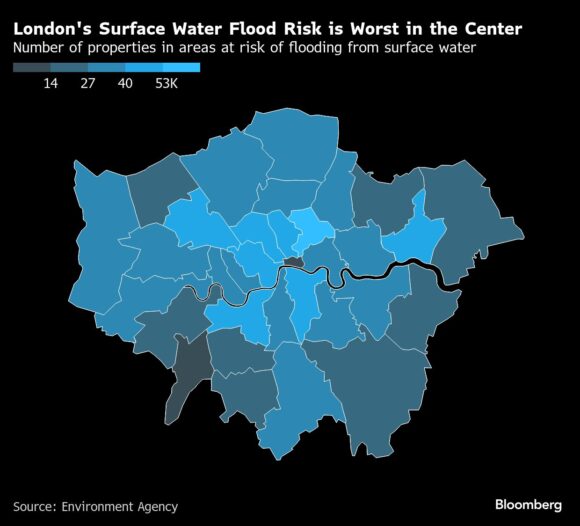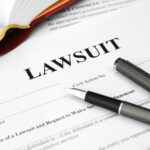As London struggles to adapt to the reality of more frequent and powerful floods, its wealthier corners are emerging as some of the most at risk.
Last month in the affluent London neighborhood of South Hampstead, homeowners packed a community hall for an event dedicated to preparing for the next big flood.
Attendees had good reason to be there. South Hampstead —where the average price for a home is over £1 million ($1.3 million) — stands out as one of the areas that was hard hit by flash floods in July 2021. Back then, a month’s worth of rainfall was dumped on London in just a few hours. Some of the UK capital’s wealthiest neighborhoods — Kensington, Chelsea and Westminster — were among the worst affected.
It was a seismic event that altered peoples’ perceptions of what it means to live in London. Guy Meacock, a director at UK property buying consultancy Prime Purchase, says flood insurance for home-buyers “was just not talked about years ago.” But it’s “very much a real issue now.”
Homeowners living in some of London’s priciest real estate are now trying to figure out how more frequent and destructive floods will affect both their access to insurance and their property values. That’s as rising temperatures affect cloudburst patterns in ways that are exposing well-established urban areas with ageing Victorian-era infrastructure to unprecedented strains.
A high-end property’s exclusive design can often amplify flood risks, says Rachel Gilliam, head of private clients at Lockton, an insurance broker. Sweeping driveways and hard-landscaped city gardens increase water runoff. And below ground, luxury basements that house everything from super cars to art and technology are an added flood risk.
Gilliam, who declined to identify individual properties or clients by name, says she saw a single claim for 2021 flooding in the Notting Hill area for more than £600,000; another in Hampstead was over £1 million, she says.

Londoners are getting trapped not just by rapidly evolving weather patterns, but also by changes in regulations and shrinking access to insurance.
Meacock at Prime Purchase, who also declined to identify clients due to the sensitivity of the matter, says flood risk became a dealbreaker for buyers he was advising on a multimillion-pound home in Wimbledon last year. The house, which Meacock says had never been flooded, even had state-of-the-art flood protection, including underground pumps. But it also had a basement, which was added as part of a major refurbishment in 2010.
Insurers walked away, deeming the property to be ineligible for cover by Flood Re, a government-backed reinsurance plan that isn’t available to properties built after 2009. The buyers tried 10 separate insurers via two brokers. Most of the time, Meacock says it was just a case of the “computer says no.”
After spending nearly £30,000 on legal and survey fees, the buyers finally found an insurer willing to cover the house. By that stage, however, they were sufficiently unnerved to ultimately opt for a different property without a basement, Meacock said. Now, every time he takes on a new client, he insists they check early on in the process to find out whether the property can be insured for flood risk.
Luxury Basements
Homeowners with premium properties and large basements increasingly face their own unique risks. Since the 2021 floods, insurers have been offloading such homes to Flood Re, which saw a 20% jump in policies in the financial year through March. Flood Re has in turn raised the premiums it charges insurers to as much as £1,600 a year per house, in part as its risk profile evolves to reflect more high-value claims.
“It’s very rare now to find a property in London with a basement that the insurance companies wouldn’t look to cede to Flood Re,” says Ryan Clay, associate director in the new business department at the insurance broker SPF Private Clients, speaking specifically about high-end property. Flood Re is itself intended as a stopgap that’s set to end in 2039.
Londoners are sheltered from the worst river flooding by the Thames Barrier, a 40-year-old retractable flood defense that protects the city from storm surges and tidal flooding. It’s expected to be effective until 2070, after which rising sea levels mean it will no longer be fit for purpose.
But Elizabeth Rapoport, chair of Flood Ready London, a partnership betweengovernment authorities and the local water company, says homeowners often misunderstand where the real risks lie. “If you are worried about flooding in London, the rivers are not your problem,” she says. “You should be worried about surface water.”
She also says that “a lot of the wealth in London is” due to “the fact that the land is worth so much.” But if “you can’t get insurance for the building on it, the values really start to collapse,” Rapoport said. It’s “like a house of cards.”
The challenge is compounded in a city with a tricky patchwork of landowners and unclear responsibilities, says Rapoport. She emphasizes that those most at risk are people living in basement flats who can’t afford expensive protections, and where flash-flooding in extreme scenarios can become life-threatening. In July 2021, there was also severe flooding in east London, jamming roads and public transport.
As many homeowners in London look for quick fixes to help flood-proof their homes, some businesses are eyeing an opportunity. Watertight International, a flood resilience company based in the north west of the UK, is now planning to expand in the capital, says operations director Mark Arrowsmith.
Standard solutions include pumps, self-closing air vents, and waterproof doors and gates, as well as valves that can be fitted to pipes to stop sewage flowing into a house when water levels rise. Watertight, which presented many of these solutions to residents at the South Hampstead event in October, also provides customized flooding plans that include advice not just on how to protect the home, but also on how to plan an escape if water levels rise at a dangerous pace.
Mary Long-Dhonau, who’s been advising UK flood victims and campaigning for their rights for 25 years, was among those present at the October community-hall gathering in South Hampstead.
“I’ve been flooded myself – I know what you’ve all been through,” she told the audience. “The recovery from a flood is worse than the flood itself.”
Photograph: Properties by the River Thames after the river burst its banks following heavy rain near Kew Bridge in London, in 2016. Photo credit: Justin Setterfield/Getty Images
Was this article valuable?
Here are more articles you may enjoy.



 Aon Adds to List of Brokers Suing Howden US for Alleged Poaching, Theft
Aon Adds to List of Brokers Suing Howden US for Alleged Poaching, Theft  Three Top P/C Insurers Account for Most of Insurance AI Patents
Three Top P/C Insurers Account for Most of Insurance AI Patents  Senators Launch Probe Into Demotech’s Ratings in Florida
Senators Launch Probe Into Demotech’s Ratings in Florida  Twice Injured Firefighter Loses Second Workers’ Compensation Claim
Twice Injured Firefighter Loses Second Workers’ Compensation Claim 

